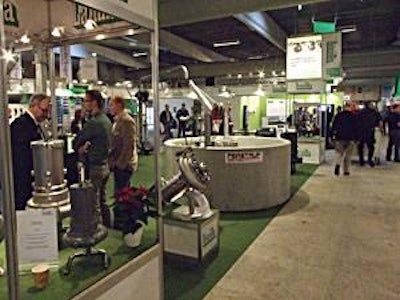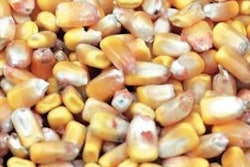
Because feed is the biggest cost in pig production, feeding systems must deliver wet or dry feed efficiently with a minimum amount of waste.
Liquid feeding is very popular in Europe and many producers have survived bad times using by-products such as whey or brewery waste. Performance may not be as high but the cheap feed costs compensate. Increasing transport costs reduce the attractiveness of these feed sources however.
Nevertheless, even just feeding conventional rations mixed with water – called “soup“ in France – has some advantages over dry feed, not least in cutting wastage. Danish famers have been fans of liquid feeding for many years, probably dating back to the time when all Danish farmers had Landrace pigs and Danish Red cows.
The milk went to the dairy to make butter and the skimmed milk was brought back to the farms to be fed to the pigs along with a ground feed. Things have naturally changed since then. For example, today it’s possible to put 7kg (15lb) weaner pigs straight on to liquid feed. Originally, it was only possible to feed a 3: 1 water: feed mix. This was alright for sows and finishers but that ratio didn’t allow a very small pig to take in enough dry matter (DM) to grow well.
Liquid feeding technology
Modern technology makes it possible to pump feed with a much higher DM content and much younger pigs can be successfully wet fed averaging 650 grams a day from 7-30kg. The technology involved is explained by Jesper Vaerens of ACO-Funki, who explains that the ACO-Funki liquid feeding system is run by a PC using Windows XP software.
A back up program is kept on a memory stick and should the system crash the whole program and data can be downloaded from the stick. ACO–Funki uses a batch system – described as “soil to table” by Jesper. All the feed rations can be individually specified for each group of pigs. Plus, there are many options in terms of frequency of feeding. For example, weaners might be fed four times a day with two different feed mixes.
The system is programmed to check on the amount of power used when ingredients are ground. If excessive power is being used, the whole system is slowed down. Should the system get overloaded then all operations can be automatically shut down, to avoid burning out the motor. Additionally, a just-in-time option allows ingredients to be milled when required and in precise amounts.
Pre-mixer holding hoper
Hugo Holm, CEO of Big Dutchman (Skandinavien) A/S demonstrated its pre-mixer holding hopper at the 2009 Agromek trade fair in Herning, Denmark in late November. This hopper has a 2,000-litre capacity and sits directly above a BDS dry mixer. While a batch is being mixed, ingredients such as wheat, barley, soya and VATM are fed by weight into the holding hopper. Once the mixer is emptied, a pneumatically operated base plate opens allowing the next mix to drop by gravity into the now empty mixer.
Often the mixer is a bottleneck in a mixing operation and this system may help the process become continuous, boosting output.
“For best performance pig feed needs to be very finely ground,” says Holm. “The problem is that often as the grind diameter decreases, so does mill output and heating of the milled feedstuff increases. The MBM mill is specially shaped so it draws extra air into the mill to increase the grinding capacity and reduce heating up of the ground grain, which reduces the risk of bridging and mould formation.”
Commenting on wet feeding Holm added, “Fermentation of wet feed used to be quite common but has practically died out. The technique of fermentation to reduce the pH of the feed, thereby acidifying it to help gut health was fine, but to achieve good results required a great deal of skill. Another downside is that lactic acid destroys any synthetic amino acids included in the feed.”
Dry feeding milking sows
Danish sows are effectively pig machines — 35 pigs per sow per year is not far away according to top industry advisers. To achieve this output, it is vital that sows are well fed to milk well and of course not lose condition. Shoulder sores are problematic when sows lose body weight and condition. Bandages have been tried, but are hardly practical for pigs.
Generally, breeding farms have a few hospital stalls part floored with rubber matting which gives relief to sows with such sores. Liquid feed systems can be programmed to deliver feed three to four times or even more, usually over a 12- hour period. Some producers though prefer to dry feed their milking sows but the objective is the same — get feed into the sow.
Egebjerg International exports pig equipment and has released the GeStall sow feeder for pig producers who dry feed milking sows. “Given that sows lactate longer in Denmark than in the United States or Canada, we feel this feeder has great potential in Denmark,” says Carsten Rasmussen, Egebjerg’s chief market manager.
The feeder, which bolts on to the sows’ feed trough, is controlled by wireless technology and is fitted with a small dispensing auger. An electronic feed activator sits in the bottom of the trough and when the sow noses the activator, more feed is released. Significantly, the sow must empty the trough before she can get more feed.
The associated software allows for real-time monitoring of each sow’s feed intake plus critically detects when sows are eating too little. Automation is gradually taking over, even where the feeding of lactating sows is concerned, because labour is expensive and not always of the desired quality. Units will get bigger and bigger and this means machines will replace humans wherever possible.


.jpg?auto=format%2Ccompress&fit=crop&h=167&q=70&w=250)














